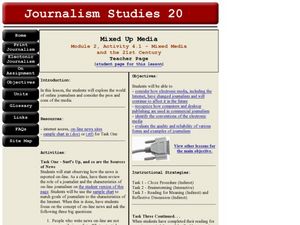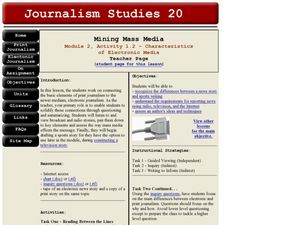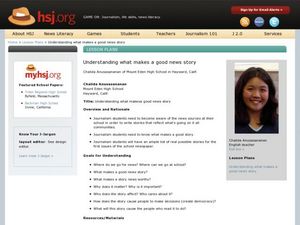Curated OER
A News Story of Your Own: Sentence and Lexical Variety
Given the two-sentence skeleton of a news story about a car theft/joy ride, budding writers create their own version of the story varying diction and sentence structure to heighten interest and complexity in their writing. Resource...
Curated OER
Opinion through the Ages: Exploring 40 Years of New York Times Op-Eds
What is the role of a newspaper's Op-Ed page? High schoolers explore the New York Times' "Op-Ed at 40," an interactive feature that lets them browse through 40 years worth of op-ed features, and consider the purpose and value of this...
Curated OER
During Reading Strategy: Literary Newspaper
Add some writing to your class's reading of Cold Sassy Tree! With this plan, readers assume the role of journalist and create a segment of a paper with their peers. Suggested segments are included, and a worksheet dividing the text into...
Macmillan Education
A Class or Company Newsletter: A Collaborative Writing Lesson
A class newsletter? The possible extensions for this activity are endless. After examining examples of news print-outs from hotels or workplaces, class members develop their own articles and produce a newsletter. A great way to keep...
Curated OER
Bias and Crime in Media
Critical thinking and social justice are central themes for this resource on bias and crime in media. The class views and discusses an incisive PSA that highlights assumptions based on race. Small groups read newspaper opinion pieces...
Media Smarts
How to Analyze the News
Teach kids how to watch television, specifically the news, with this creative idea for learners of all ages from the Media Awareness Network. The elementary school plan focuses on presenting news as a story and uses Jon Scieszka's story...
Media Smarts
Marketing to Teens: Gender Roles in Advertising
Young learners explore gender roles in advertising by taking an ad campaign they have seen which is specifically directed to one gender, and redesigning the campaign to target the opposite gender. After leading a guided discussion about...
Curated OER
Marketing to Teens: Introduction
An introductory lesson shows learners how pervasive and influential advertising is in our culture; particularly, how teenagers are actively targeted by advertisers. As teenagers, your students already have all the information they need...
Curated OER
Shaping the News
Students explore television journalism. In this journalism lesson, students discuss the attributes of television broadcasting. Students then review their journalism code of ethics and then conduct research for stories that have a moral...
Curated OER
Beyond the Printed Word
Students investigate the effects of television and radio on culture. In this journalism lesson, students consider how electronic media has shaped journalism as they create timelines that feature the changes and compare and contrast print...
Curated OER
Mixed Up Media
Young scholars explore online journalism. In this journalism lesson plan, students discover how electronic medias are changing journalism, examine the conventions of electronic media, and discuss the authority and reliability of forms of...
Curated OER
Mining Mass Media
Students take a closer look at the attributes of electronic media. In this journalism instructional activity, students compare and contrast electronic and print versions of the same news stories. Students then write their one broadcast...
Curated OER
Freedoms of the Press
Learners examine journalism ethics. In this journalism lesson, students complete a think, pair, share activity about the journalistic code of ethics. Learners then discuss an ethics scenario.
Curated OER
Investigative Reporting: Module 3 'On Assignment'
Students choose and create an investigative journalism piece. For this journalism writing lesson, students work in groups to develop and investigative television show. The end result is for students to create a video with a 40 minute run...
Curated OER
The Power of One: Convergence in Scholastic Media
Pupils explore the different forms of media utilized by journalism including writing, photography, video, sound and the Internet. In this journalism lesson, students compare and contrast the ways in which information is presented between...
Curated OER
The Electric Experience
Students investigate the effects of television and radio on culture. In this journalism lesson, students consider how electronic media has shaped journalism as they create timelines that feature the changes and compare and contrast print...
Curated OER
Understanding What Makes a Good News Story
Students explore the news sources at their school in order to write stories that reflect what's going on in all communities and to identify what makes a good story. In this news writing lesson, students journal about what makes a...
Curated OER
Where are your borders?
Students explore the meaning of borders, both real and symbolic. After viewing film footage and visiting poetry websites, they develop their own point of view. To express their perspective, they are to write a journalism poem, or...
Curated OER
Learning Types of Editorials - and Writing Some
Young scholars recognize and differentiate between the three types of editorials in order to write editorials for the school newspaper. In this editorials instructional activity, students read example persuasive and interpretative...
Curated OER
Dissecting the Media
Students examine an editorial point of view in journalism and explore how this contributes to the West's understanding of events in the Middle East. They discuss the concepts of objectivity and subjectivity, and how tone and vocabulary,...
Curated OER
Ida Tarbell: Hysterical Woman vs. Historical Facts
Learners examine journalism and its different styles. In this effective communication instructional activity students create an editorial message and articulate an article.
Curated OER
Who, What, Where, When, Why, How
Students take a closer look at the organization of news stories. In this journalism lesson, students identify the elements of news stories and then write their news stories on the same topics using different types of leads.
Curated OER
Editorial Writing: What's On Your Mind
Students write an editorial column for a newspaper. For this journalism lesson, students discuss and analyze editorials in print and broadcast media. Students will compare the differences in these two formats of editorial...
Curated OER
The First Amendment, What it Means and When Libel Comes in to Play
Students research three topics: The First Amendment, John Peter Zenger and his trial, and libel. In this journalism and libel lesson, students discuss things authority figures have done they disagree with and the anit-sedition law....
Other popular searches
- Broadcast Journalism
- Yellow Journalism
- Journalism School Newspapers
- Journalism Layout
- Journalism Lesson Plans
- Investigative Journalism
- Photo Journalism
- Broadcast
- Journalism Introduction
- Journalism History
- Radio Broadcast
- Journalism and the Media























